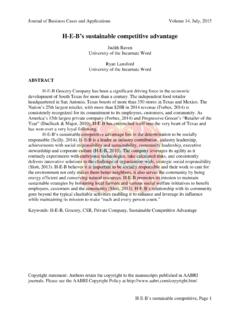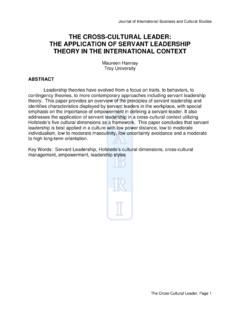Transcription of The moral hazard of mandatory membership in …
1 Research in Business and Economics Journal The moral hazard , page 1 The moral hazard of mandatory membership in private clubs Leon Hoke The University of Tampa Brian T. Kench The University of Tampa Charles Skipton The University of Tampa ABSTRACT There is a trend sweeping the private club industry in Florida, mandating that all homeowner association members pay initiation fees and dues to the private country club in their housing development. So-called mandatory membership fees are an attempt to eliminate, or at least reduce, a free-rider problem concerning the financial health of ailing private country clubs.
2 This paper argues that the implementation of mandatory memberships creates a moral hazard problem. Because of mandatory memberships, homeowners now have little to no protection from the board of directors and staff of the country club that might be interested in empire building or promoting salary and benefits increases while forcing homeowners in the housing development to pay the tab. Finally, the authors offer an explanation of how this mandatory membership moral hazard may actually lead to decreases in property values and rent transfers among the participants.
3 Keywords: agency theory, common interest community, mandatory membership , moral hazard Copyright statement: Authors retain the copyright to the manuscripts published in AABRI journals. Please see the AABRI Copyright Policy at Research in Business and Economics Journal The moral hazard , page 2 2 INTRODUCTION There is a trend sweeping the private country club industry, mandating that all common interest association members pay initiation fees and dues to the private country club in their private community. In many cases, private country clubs have fallen on hard times and are threatening to go bankrupt, thereby negatively affecting housing values in the housing development.
4 The argument made by the private golf clubs for mandatory membership fees is that as housing values in the development surrounding the golf course are positively impacted by the success of the golf club so should all of the home owners within the community contribute financially to the well-being of the private country club. Hence, mandatory membership is an attempt to eliminate, or at least reduce, an individual home owner s incentive (within the housing community possessing the golf club) to let someone else pay for the costs of these ailing clubs.
5 In the jargon of economics, mandatory membership is an attempt to eliminate a free-rider problem where the public good is the golf club (with its manicured greens) and the non-excludable parties (who benefit from the positive externalities created by the club) are the proximal property owners within the housing development. In short, the argument for mandatory membership is one which endeavors to bring an efficient level of golf course / club provision to a market where the potential for under provision exists. Though economic efficiency arguments for mandatory membership contracts suggest their use in some cases, they can have a dark side.
6 mandatory membership fees create a moral hazard problem where the interests of the principal (both the home owners and the private owners of the club) are no longer in line with those of their agents (both the board of directors, hereafter BOD, and staff of the club). Once mandatory membership is in place, the principals have little to no protection from a BOD and staff whose personal interests may be empire building, while the home owners pay the These issues, along with an explanation of how the potential for the moral hazard problem may actually lead to decreases in property values and rent transfers among the various participants, are addressed here.
7 The next section reviews the common interest community governance structure and its treatment by courts. Section three lays out the current state of the golf industry. Section four introduces the concept of mandatory membership to a country club and how the Court has treated such contracts. Section five argues that mandatory membership programs are a poor organizational design mechanism to solve the financial problems of country clubs. The last section concludes the paper. 1 Empire building describes the actions of decision makers to maximize the size of their division s budget, number of employees, size of facility, etc.
8 , instead of maximizing its profits (or minimizing its costs). Such behavior is often suggested to occur whenever decision makers are neither residual income claimants nor compensated in some fashion which explicitly aligns the interests of the principal and the agent. In the public choice literature, which studies government decision making, the study of such behavior is called bureaucracy theory (see Niskanen, 1996). Research in Business and Economics Journal The moral hazard , page 3 3 COMMON INTEREST COMMUNITY GOVERNANCE More than 62 million American live in common interest communities in which owners of separate real estate parcels have some common interest that is owned and managed by a Drewes (2001, ) writes that common interest communities attract investors because they (1) seem to provide traditional services such as trash collection more efficiently than a local government, (2)
9 Enable an investor to acquire private access rights to golf courses, tennis courts, and other amenities that otherwise they otherwise could not afford, (3) efficiently regulate conduct within the boundaries of the community, and (4) foster a belief by investors that such restrictive regulations and other services provided ensure that property values will remain high. Examples of common interest communities include gated communities, condominium associations, and cooperatives. More formally, property law defines a common interest community as.
10 A real estate development or neighborhood in which individually owned lots or units are burdened by a servitude that imposes an obligation that cannot be avoided by nonuse or withdrawal (a) to pay for the use of, or contribute to the maintenance or, property held or enjoyed in common by the individual owners, or (b) to pay dues or assessments to an association that provides services or facilities to the common property or to the individually owned property, or that enforces other servitudes burdening the property in the development or Common interest communities have restrictive covenants4 or constitutions that are tied to land and are enforceable against the initial owner entering into the contract and the covenant is also tied to any future owner of the property.










